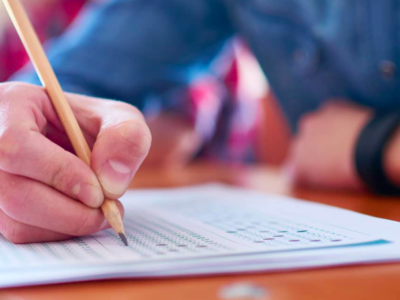Imagine you’ve made it to test day; you’ve paid your registration fees, put in months of preparation, and finally, you’re mentally ready to tackle the big test. You approach check-in, anxiously awaiting the start of the exam, and – wait what? Can’t use my calculator? Why not?
The truth is, calculators are permitted on the SAT, but not ALL calculators. There are specific calculators that aren’t allowed on the exam and if you show up with one, you won’t be able to use it.
Not having a calculator on the SAT isn’t a total deal-breaker, and it’s possible you could still get an okay score. However, calculators are permitted on the SAT for a reason and if you’ve completed all of your test prep with a calculator, suddenly trying to complete the test without one could throw a serious wrench into you achieving the score you want.
Basic Calculator Rules
Before I get into what calculators are allowed on the SAT, it’s important that you know how they are allowed to be used on the test.
1. Calculators are not provided and cannot be shared
Double and triple-check that you have your calculator ready and charged before going to bed the night before the big test. Even if you know where it is, don’t leave any risks for the morning of your SAT. Ensure you have your calculator and that it’s in the approved list below.
2. Seriously. Don’t share your calculator
If you make any attempt to share your calculator with another student or try to use it to take test questions or answers out of the test room, you’ll be dismissed from the test and your scores will be canceled.

3. You may only use your calculator on the SAT Math Test – Calculator portion of the test
This seems self-explanatory but remember, there is a Math section on the SAT that prohibits calculators. Don’t try to be sneaky, and don’t risk getting kicked out.
Approved Calculators for the SAT
Here is the official list of accepted calculators straight from College Board. All scientific calculators are acceptable, all 4-function calculators, including those with square root and percentage keys, are allowed (but not recommended), and most graphing calculators are acceptable as long as they don’t have any features I’ve listed below under “Unacceptable Calculators.”
Casio
| FX-6000 Series | FX-6200 Series | FX-6300 Series | FX-6500 Series |
| FX-7000 Series | FX-7300 Series | FX-7400 Series | FX-7500 Series |
| FX-7700 Series | FX-7800 Series | FX-8000 Series | FX-8500 Series |
| FX-8700 Series | FX-8800 Series | Graph25 Series | FX-9700 Series |
| FX-9750 Series | FX-9860 Series | CFX-9800 Series | CFX-9850 Series |
| CFX-9950 Series | CFX-9970 Series | FX 1.0 Series | Algebra FX 2.0 Series |
| FX-CG-10 | FX-CG-20 Series | FX-CG-50 | Graph 35 Series |
| Graph 75 Series | Graph 95 Series | Graph 100 Series | FX-CG-500** |
Hewlett-Packard
| HP-9G | HP-28 Series | HP-38G |
| HP-39 Series | HP-40 Series | HP-48 Series |
| HP-49 Series | HP-50 Series | HP Prime |
Radio Shack
| EC-4033 | EC-4034 | EC-4037 |
Sharp
| EL-5200 | EL-9200 Series | EL-9300 Series |
| EL-9600 Series** | EL-9900 |
Texas Instruments
| TI-73 | TI-80 | TI-81 | TI-82 |
| TI-83 | TI-83 Plus | TI-83 Plus Silver | TI-84 Plus |
| TI-84 Plus CE | TI-84 Plus CE Python | TI-84 Plus Silver | TI-84 Plus C Silver |
| TI-84 Plus T | TI-84 Plus CE-T | TI-84 Plus CE-T Python Edition | TI-85 |
| TI-86 | TI-89 | TI-89 Titanium | TI-Nspire |
| TI-Nspire CX | TI-Nspire CX II | TI-Nspire CX II-T | TI-Nspire CM-C |
| TI-Nspire CAS | TI-Nspire CX CAS | TI-Nspire CX II CAS | TI-Nspire CX II-T CAS |
| TI-Nspire CM-C CAS | TI-Nspire CX-C CAS | TI-Nspire CX II-C CAS |
Other
| Datexx DS-883 | Micronta | NumWorks | Smart2 |
Unacceptable Calculators
Though that list seems extensive, if you didn’t see your calculator up there, please note that the following features are prohibited from the exam. Calculators that are not accepted by College Board are:
- Models that can access the internet, have wireless, Bluetooth, cellular, audio/video recording and playing, camera, and any other smartphone-type features.
- Models that have a computer-style (QWERTY) keypad, pen input, or stylus.
- Models that use electrical outlets, make noise, or have a paper tape.
- Models that are considered laptops or other computers, tablets, mobile phones, smartwatches, or wearable technology.
Note: Some models with touchscreen capability are not approved. If you are concerned about your calculator falling within the parameters of unaccepted features, it may be best to avoid the risk and bring a device you see on the list of approved calculators instead. Look into this early, you don’t want to be stuck using a calculator you are unfamiliar with for the first time on SAT day.
Using Your Calculator Strategically
I won’t bore you with the details of how to use a calculator, I would hope by this point you’re roughly familiar, but you should know that there are key tricks to make sure you’re using your calculator in an efficient way on the exam.
1. Calculators aren’t always necessary
Although there is a math section on the SAT that permits calculators, that doesn’t mean they are always necessary for solving each question on that section. In fact, using your calculator when it’s not needed has the potential to slow you down and lose you valuable time on the test.
Make sure you’re reading through the questions before starting calculations or formulating equations. Some questions won’t test your ability to solve, but instead, your ability to understand and organize information. Don’t waste time trying to complete calculations when it isn’t needed!
2. Speeding up small calculations
If it isn’t already clear, moving quickly is imperative for the SAT. Smaller calculations, like converting fractions to decimals, can take up time when calculating by hand and even more time if you make accidental errors along the way. Utilizing your calculator to complete these functions can help problem solutions go more smoothly.
3. Utilizing the graphing function
The SAT may ask you to identify an equation that matches a provided graph. You could analyze the points provided and solve for the equation, but you could also just use the graphing feature of your calculator to get the answer done faster.
The SAT also permits 4 function calculators but doesn’t recommend them. A graphing or scientific calculator that you’re familiar with can be a real help on more complex questions.
What’s the Best Calculator for the SAT?
Any of the calculators on the approved list above are great for the SAT. There isn’t one calculator that offers an advantage over the others. Here are a few factors that make a calculator a good calculator:
1. You know how to use it.
This seems obvious, but you’d be surprised. Some students are under the impression that they’ll need a more complex calculator for the SAT but don’t put effort into practicing how to use it. A calculator with graphing features is useless if you don’t know how to get to them. Most students will have had experience with a graphing calculator, but if you haven’t, whatever calculator you’ve been using while studying is just fine. If you plan on using a new calculator for the test or are borrowing a friend’s, spend some time getting familiar with it before test day; you want to limit as many surprises as possible.
2. It does what you need it to do.
Another simple one, but just as important. If you’ve been working through your SAT prep and are having issues with your calculator not having certain features or noticing certain things are more complicated than they need to be, it may be best to consider using a different one for the test (#1 still applies). You’ll be under some pressure when the test starts and you don’t want to be pulling your hair out over your calculator – the test questions will already have that effect, you don’t want to double down.
3. It’s reliable.
If you have a newer calculator, you might not need to worry about this one, but if you were like me and used an old hand-me-down graphing calculator you should listen up. The SAT is not the place to risk your calculator failing on you. On mine, for example, the “2” button only worked sometimes. Needless to say, I borrowed a friend’s calculator when I took the SAT. This same thing applies to calculators that have a hard time holding a charge, dim screens, glitches, and everything else. Although you may have an emotional attachment to your ye olde brick machine, it’s not worth the risk of your calculator not working when you really need it to.
4 (kind of). It’s not a four-function calculator.
As mentioned before, you can use four-function calculators on the SAT but they aren’t recommended by College Board and for good reason. Think about it like this: if you’re running a race you can wear flip flops, but that doesn’t mean running shoes wouldn’t be better. Four-function calculators are incredibly limiting and make you do extra work that a scientific or graphing calculator could otherwise do for you. If you’re most comfortable using a simplified calculator, go for it, but know that there are other more efficient options available.

Conclusion
The truth is, whatever calculator you have – so long as it’s on the list of approved calculators – is probably good enough for the test. Try arranging to have the calculator you use for test prep be the same calculator you use for the real deal; this will help you get used to using the calculator and help you move more quickly. Remember: your calculator is supposed to help you, not hinder you. Make sure you know how it works and how to use it efficiently.










Comments